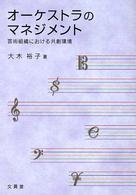Full Description
Scholarship on artistic output during second wave feminism (SWF) primarily reflects art-genres such as visual art, performance art, literature, and poetry. In The Women's Music Movement: Music as Feminist Praxis, 1973-1980, Paul Ambrose Shaw III contends the women's music movement (WMM) was a vibrant locus of feminist activity during SWF but received comparatively less scholarly attention. Specifically, Shaw conducts a content analysis of five songs recorded between 1973 and 1980. As such, he draws on musical elements and structures, poetic and lyrical devices, personal insights from the artists, and feminist theory to explore the following important questions: What can we learn about second wave feminist movement through the lens of the women's music movement? Was the women's music movement, as some scholars and activists assert, simply a cultural and lifestyle movement, or an impactful locus of feminist praxis? Through a detailed analysis of five songs recorded by stalwarts of WMM—Meg Christian, Cris Williamson, Ferron, Holly Near, and Linda Tillery—Shaw argues for the importance of WMM as a vibrant center of struggle, growth, and creativity that serves as a model for modern social movement cultural activity.
Contents
Preface
Acknowledgements
Introduction: Why This Study?
1 How a Musical Lens Can Inform SWF Narratives
1 Feminism and Women's Music: Definitions, Context, and Terms
1 Intersectionality
2 Background
3 Context
4 Abbreviations
2 Considerations: Epistemology, Feminist Criteria, Gender and Pop
1 Epistemology and Feminist Art Criteria
2 A Case for more Musical, Lyrical (Semiotic) Scholarship: Gender and Pop
3 Music as Social, Personal, and Political
4 Analysis Process: Limitations, the Songwriters, and the Songs
1 A Note on Process
2 Limitations and Assumptions
3 The Songwriters
4 The Songs
5 Meg Christian's "Valentine Song"
1 Rhythm (Foundational Rhythm, Time Signature, Tempo, Delay, Anticipation, Repetition)
2 Melodic and Harmonic Features (Key Signature, Vocal Range, Homophony, Polyphony, Texture)
3 Form and Style (Variation, Unity, Repetition)
4 Dynamics
5 Musical Example
6 Timbre (Color, Tone, Inflection)
7 Lyrics
8 Valentine Song (Meg Christian) Guitar Capo 1st Fret (actual key-Ab)
9 "Valentine Song" Conclusion
6 Ferron's "Ain't Life a Brook"
1 Rhythm (Foundational Rhythm, Time Signature, Tempo, Delay, Anticipation, Repetition)
2 Musical Example
3 Melodic and Harmonic Features (Key Signature, Vocal Range, Homophony, Polyphony, Texture)
4 Form and Style (Variation, Unity, Repetition)
5 Dynamics
6 Timbre (Color, Tone, Inflection)
7 Lyrics
8 Ain't Life a Brook (Ferron) Guitar Capo 7th Fret (Actual Key-D)
9 "Ain't Life a Brook" Conclusion
7 Cris Williamson's "Sister"
1 Rhythm (Foundational Rhythm, Time Signature, Tempo, Delay, Anticipation, Repetition)
2 Melodic and Harmonic Features (Key Signature, Vocal Range, Homophony, Polyphony, Texture)
3 Form and Style (Variation, Unity, Repetition)
4 Dynamics
5 Musical Example
6 Timbre (Color, Tone, Inflection)
7 Lyrics
8 Sister (Cris Williamson) Original Key-C (for Piano or Guitar)
9 "Sister" Conclusion
8 Holly Near's "Riverboat"
1 A Note on Inclusion: Why Near?
2 Rhythm (Foundational Rhythm, Time Signature, Tempo, Delay, Anticipation, Repetition)
3 Melodic and Harmonic Features (Key Signature, Vocal Range, Homophony, Polyphony, Texture)
4 Form and Style (Variation, Unity, Repetition)
5 Dynamics
6 Timbre (Color, Tone, Inflection)
7 Musical Example
8 Lyrics
9 Riverboat (Holly Near) Original Key-D (for Piano or Guitar)
10 "Riverboat" Conclusion
9 Linda Tillery's "Womanly Way"
1 Rhythm (Foundational Rhythm, Time Signature, Tempo, Delay, Anticipation, Repetition)
2 Musical Example
3 Musical Example
4 Musical Example
5 Melodic and Harmonic Features (Key Signature, Vocal Range, Homophony, Polyphony, Texture)
6 Form and Style (Variation, Unity, Repetition)
7 Dynamics
8 Timbre (Color, Tone, Inflection)
9 Lyrics
10 Womanly Way (Linda Tillery) Original Key-Bb (for Piano or Guitar)
11 "Womanly Way" Conclusion
10 Women's Music Movement Conclusion
References
Index








